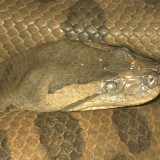RANGE
California coast and offshore islands, latitude 20 – 40 degrees (Canadian border to Mexico). The Japanese sea lion may actually be the same species.
HABITAT
Coastline.
SIZE
Males: 8 foot long, 600 pounds; females: 6 foot long, 200 pounds.
LIFE EXPECTANCY
Averages 15 – 20 years in captivity; one lived to age 30.
REPRODUCTION
- Breeding season: late May or June. Large herds of males attempt to establish individual territories on shore. (Prime locations are “beachfront”).
- Some scientists claim the bulls fast for up to 2 months while guarding their territories and the very loose harem structure which results when females come ashore to choose a place to bear their single pups.
- An old bull may collect 3 – 20 females.
- Younger bulls, even the sexually mature, form bachelor herds until about age 8
- Mating takes place within a few days of delivery, so gestation is 12 months.
- The fertilized egg does not immediately develop past a few cell divisions (delayed implantation).
- The mother cares for her pup for up to 9 –12 months and teaches it to swim.
- They nurse up to 9 months. They locate each other by voice patterns and smell.
DIET
Wild: fish, squid, octopus.
Zoo: frozen fish. The first one thrown to each has a vitamin hidden inside; we call this a “pill-fish” (not a fish species!).
BEHAVIOR
- Sea lions swim very gracefully with their front flippers.
- They are quick and agile on land, being able to rotate hind flippers forward for propulsion.
- Highly intelligent, sea lions pups play almost continuously like puppies. They throw things to retrieve and “invent” formation swimming and sliding games. Grooming, as in all aquatic mammals, is a very important activity.
POINTS OF INTEREST
- Sea lions and fur seals are easy to tell from “true seals” by their possession of external ears.
- Also, their hind flippers are less modified for swimming, allowing these animals much ore agility on land.
- The sea lion’s hind flippers can rotate forward enabling it to “run” and even jump. (It is the “seal” seen in aquariums using its ball-balancing ability, ladder-climbing, etc.).
- There are five species of sea lion, characterized by short, coarse hair with no distinct undercoat.
- It is thereby saved from a destiny as a “fun fur.”
- The California sea lion is the only sea lion with no mane, but it does make a roaring sound.
- Sea lions can swim approximately 9 miles per hour under water.
- The Navy has trained sea lions to help in recovery, down to 500 feet, of rockets gone awry.
- Any oil spill is dangerous to young pups because it mats their fur destroying its insulating quality before the pups have enough blubber to compensate. Thus, there is concern about the proposal to open the Chanel Islands to drilling. The Santa Barbara oil spill in 1969 was 3 months prior to pupping season, so there was no significant pup mortality. The pups did, however, have to increase metabolism by 50% to keep warm. Oil is most toxic in the first 24 hours after a spill.
- The most frequent cause of death is parasites, followed by man, killer whales, and sharks.
STATUS:
Small, but stable and protected population of 90,000. Some places are locally overpopulated, and there are complaints from fishermen whose gill nets may be raided.






